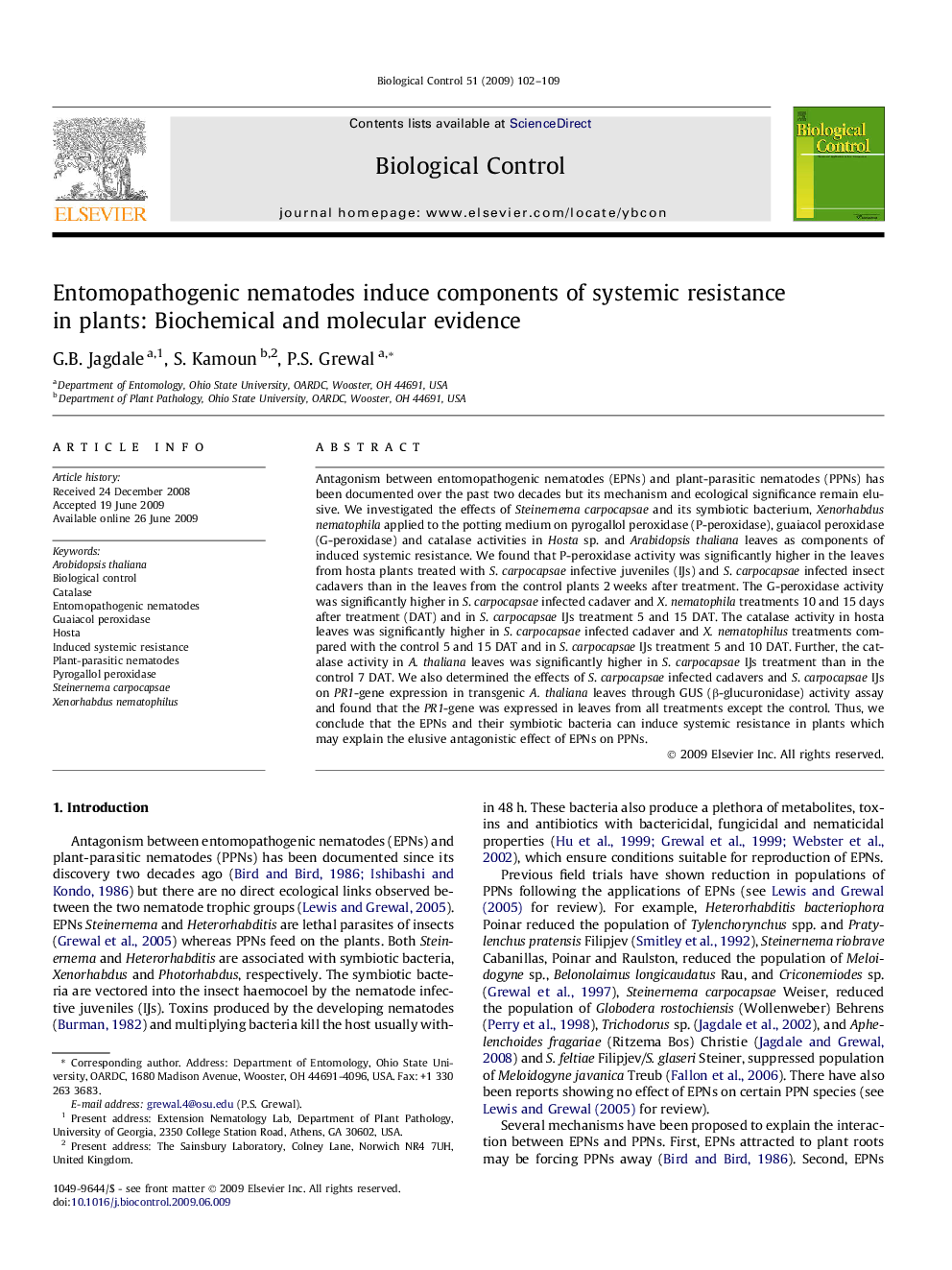| کد مقاله | کد نشریه | سال انتشار | مقاله انگلیسی | نسخه تمام متن |
|---|---|---|---|---|
| 4504518 | 1321097 | 2009 | 8 صفحه PDF | دانلود رایگان |
عنوان انگلیسی مقاله ISI
Entomopathogenic nematodes induce components of systemic resistance in plants: Biochemical and molecular evidence
دانلود مقاله + سفارش ترجمه
دانلود مقاله ISI انگلیسی
رایگان برای ایرانیان
کلمات کلیدی
HostaXenorhabdus nematophilusSteinernema carpocapsae - Steinernema carpokapsaeInduced systemic resistance - مقاومت سیستمیک منجر شدهEntomopathogenic nematodes - نماتدهای EntomopathogenicPlant-parasitic nematodes - نماتدهای انگلی گیاهیCatalase - کاتالازBiological control - کنترل بیولوژیکیguaiacol peroxidase - گوایاکول پراکسیداز
موضوعات مرتبط
علوم زیستی و بیوفناوری
علوم کشاورزی و بیولوژیک
علوم زراعت و اصلاح نباتات
پیش نمایش صفحه اول مقاله

چکیده انگلیسی
Antagonism between entomopathogenic nematodes (EPNs) and plant-parasitic nematodes (PPNs) has been documented over the past two decades but its mechanism and ecological significance remain elusive. We investigated the effects of Steinernema carpocapsae and its symbiotic bacterium, Xenorhabdus nematophila applied to the potting medium on pyrogallol peroxidase (P-peroxidase), guaiacol peroxidase (G-peroxidase) and catalase activities in Hosta sp. and Arabidopsis thaliana leaves as components of induced systemic resistance. We found that P-peroxidase activity was significantly higher in the leaves from hosta plants treated with S. carpocapsae infective juveniles (IJs) and S. carpocapsae infected insect cadavers than in the leaves from the control plants 2 weeks after treatment. The G-peroxidase activity was significantly higher in S. carpocapsae infected cadaver and X. nematophila treatments 10 and 15 days after treatment (DAT) and in S. carpocapsae IJs treatment 5 and 15 DAT. The catalase activity in hosta leaves was significantly higher in S. carpocapsae infected cadaver and X. nematophilus treatments compared with the control 5 and 15 DAT and in S. carpocapsae IJs treatment 5 and 10 DAT. Further, the catalase activity in A. thaliana leaves was significantly higher in S. carpocapsae IJs treatment than in the control 7 DAT. We also determined the effects of S. carpocapsae infected cadavers and S. carpocapsae IJs on PR1-gene expression in transgenic A. thaliana leaves through GUS (β-glucuronidase) activity assay and found that the PR1-gene was expressed in leaves from all treatments except the control. Thus, we conclude that the EPNs and their symbiotic bacteria can induce systemic resistance in plants which may explain the elusive antagonistic effect of EPNs on PPNs.
ناشر
Database: Elsevier - ScienceDirect (ساینس دایرکت)
Journal: Biological Control - Volume 51, Issue 1, October 2009, Pages 102-109
Journal: Biological Control - Volume 51, Issue 1, October 2009, Pages 102-109
نویسندگان
G.B. Jagdale, S. Kamoun, P.S. Grewal,